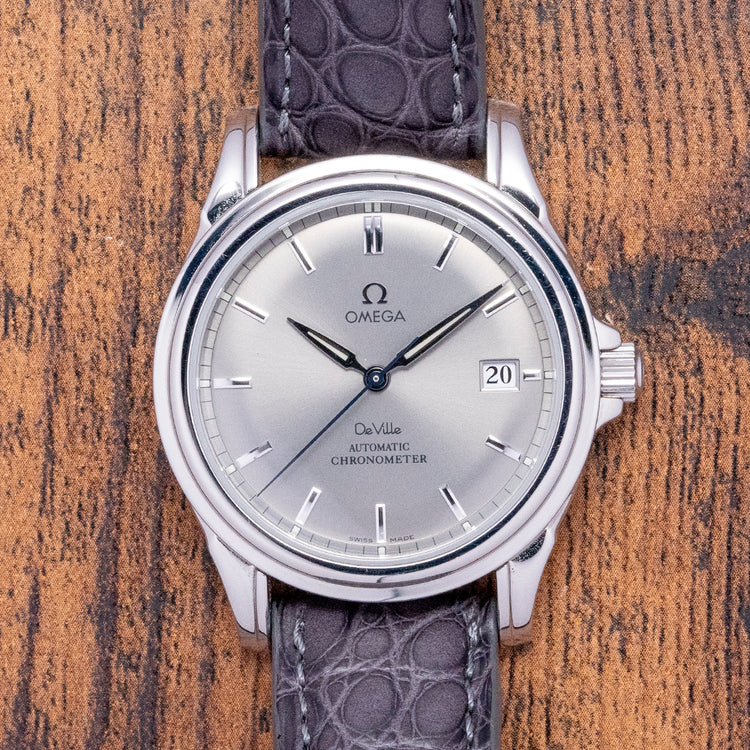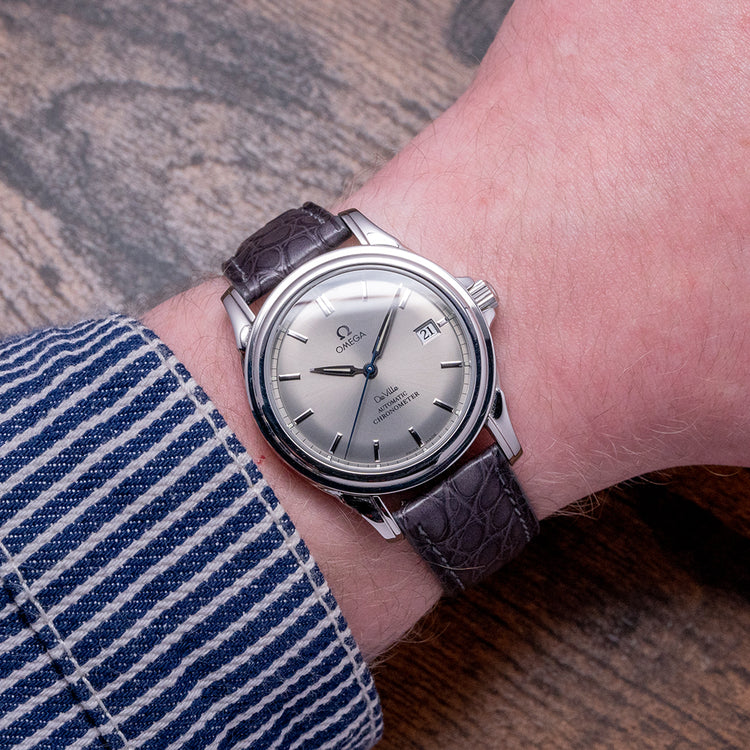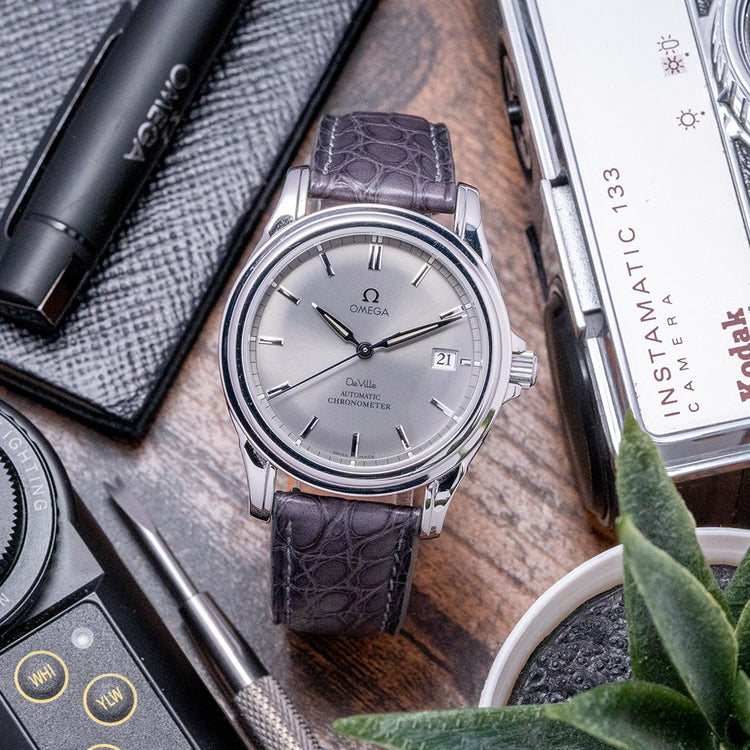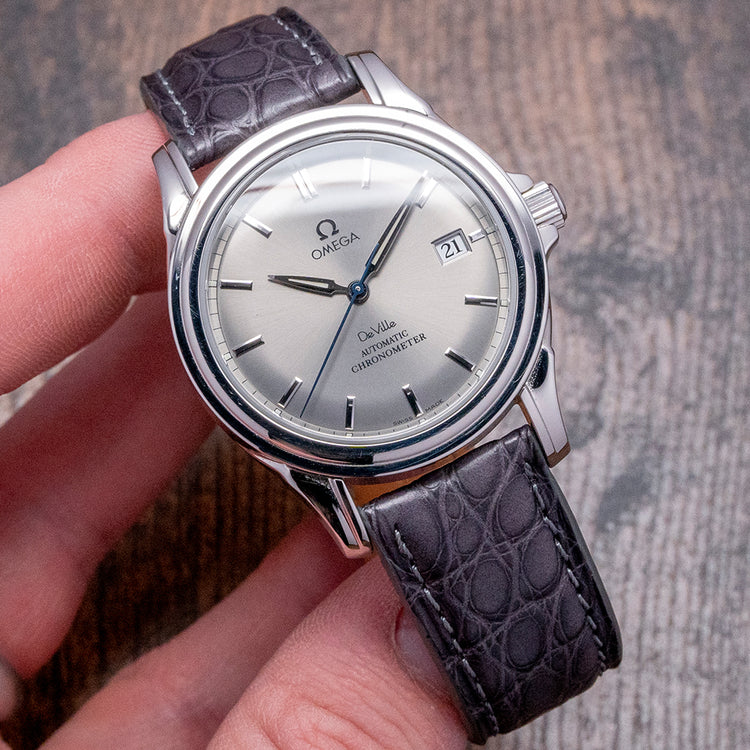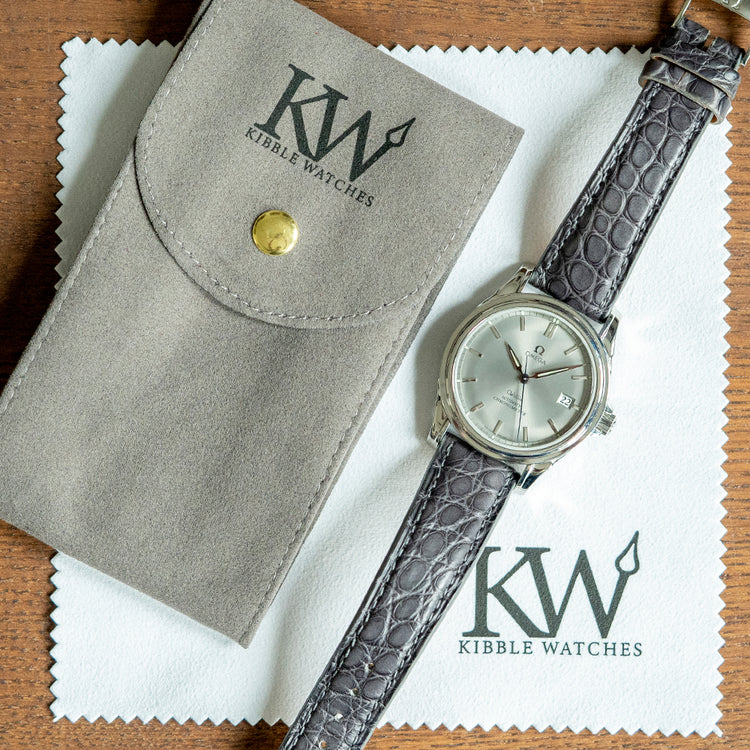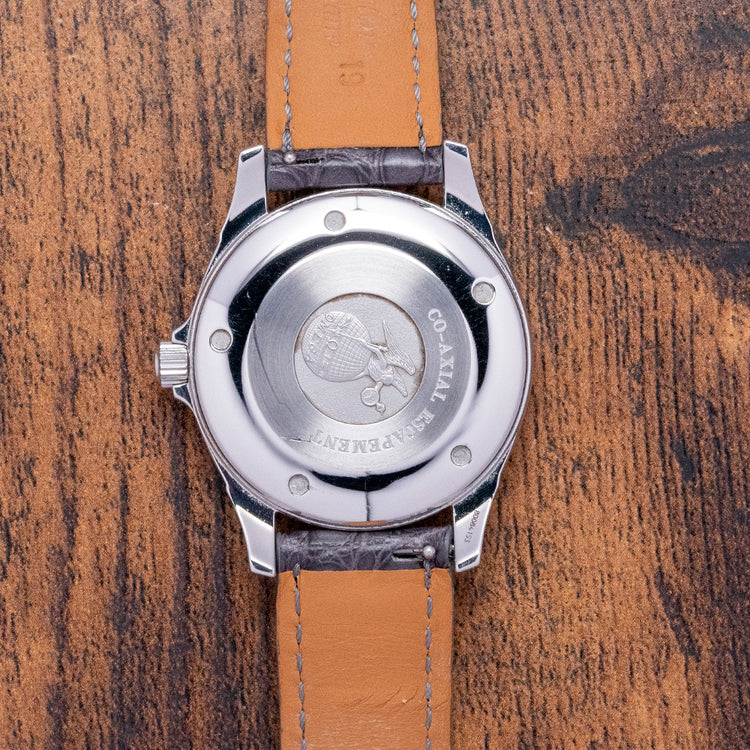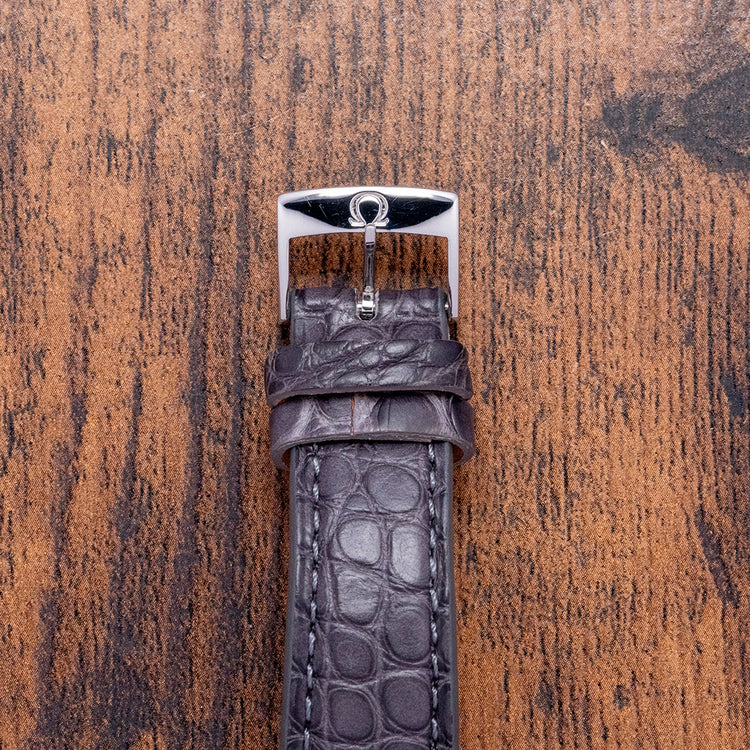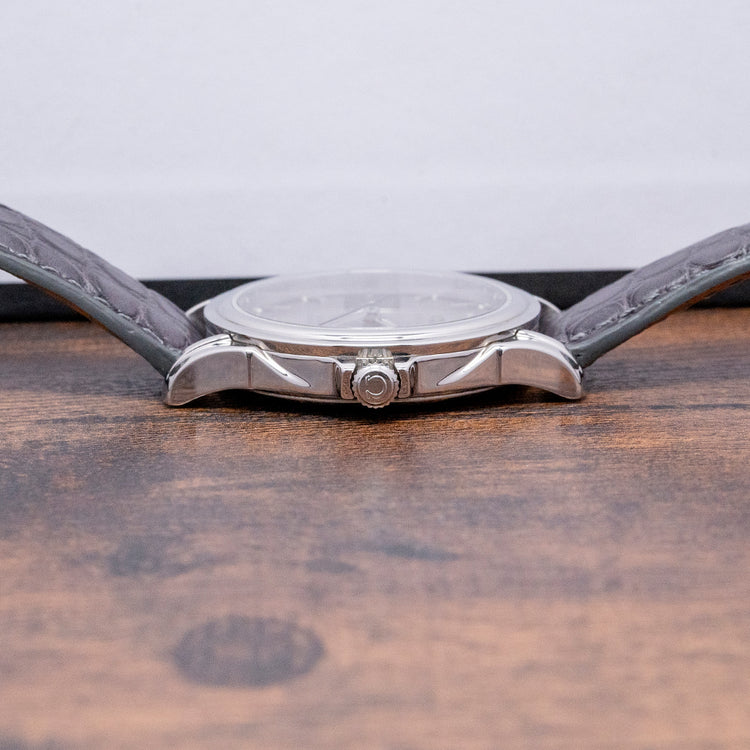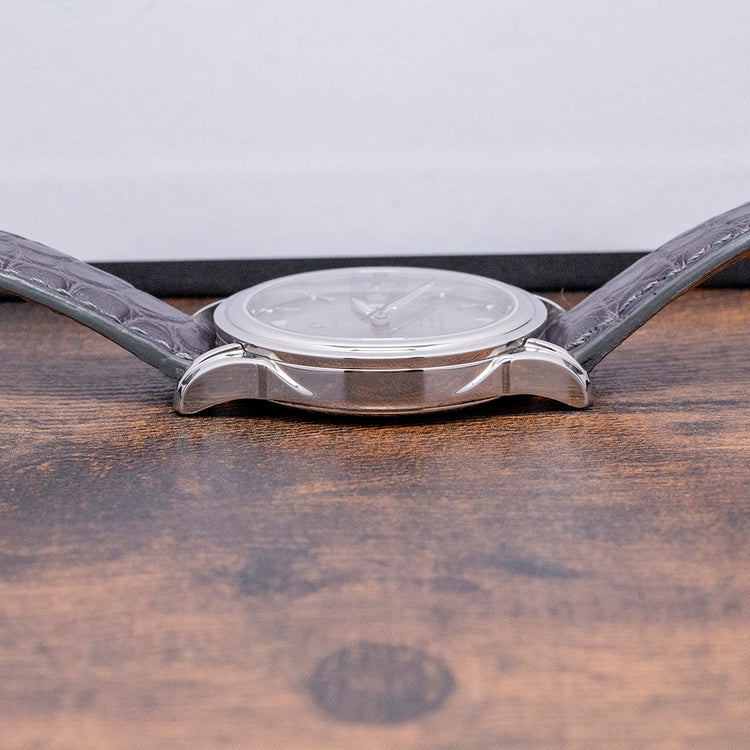More Information
Description
More
Less
The Watch
Here we have a 2002 Omega De Ville Chronometer 4831.40.31 with a 37.5mm stainless steel case that curves over your wrist thanks to the attractive thick tapered lugs, and a lug-to-lug length of 46mm and a case thickness of 9.5mm ensuring a comfortable fit. In 1967 Omega launched the De Ville as a stand-alone line, a much more streamlined, varied, and younger feel, it soon became Omega’s best-selling collection. On the right is a signed crown with deep knurling, protected by crown guards that are part of the case for strength, the stepped smooth bezel holds a domed sapphire crystal above a grey dial, and an outer minute chapter ring with lume plots surrounds applied steel bevel-edged baton indexes marking the hours, at 3 o’clock a date window, elegant Alpha style hands infilled with lume are complemented by a blue tapered sweeping second hand. At 12 o’clock we have the applied Omega motif and “De Ville Automatic Chronometer” printed at 6 o’clock completing this versatile timepiece. On the reverse a screw-down solid case back engraved with Co-Axial Escapement and the first Omega motif with the Greek God Chronos pointing at Omega with his lance, he is known as the father of time and was first used by Omega in 1895. Inside an Automatic Omega Cal. 2500, 27 jewels, beating at 25,200 beats per hour, Chronometer Certified, this quality movement introduced in 1999 is Omega’s modified version of the ETA 2892-A2, the Co-Axial Escapement is for excellent stability and durability. The watch comes paired with a 19mm aftermarket grey leather strap and original buckle.
Points of Mention
This watch is sold as "Watch Only" and therefore comes with no original Omega box or original Omega paperwork. The watch comes paired with a 19mm aftermarket grey leather strap and original Omega buckle. The watch is from Circa. 2002 based on the serial numbers on the movement and is sold in worn, vintage condition and remains in all original fair condition for its age, so comes with our 12-Months NON-Waterproof Warranty.
For more photos see here - https://drive.google.com/drive/folders/1LEacjW__iVHvBmyhxqeDELonxZxPorcL?usp=drive_link
4K YouTube video, skip to 17:38 - https://youtu.be/yzbhu5xJVAU
Personal Note
Value is something I discuss regularly here at KibbleWatches and this Omega De Ville in 37.5mm is the perfect example of value that can still be found in the watch world! Coming in at a tad over £1,500 you are getting yourself a Co-Axial Omega from 2002 with the most wonderful case profile and intriguing lugs I have seen at this price point from the brand. I would not hesitate to add this watch to your collection, I suspect it will surprise you no end how much watch you are getting for the money.
Specification
Lugs : 19mm
Condition : Pre-Owned
Box & Papers : None
Case Material : Stainless Steel
Warranty : 12-Months NON-Waterproof Warranty
The Brand
They were formerly known as the La Generale Watch Co. in 1848 founded by Louis Brandt in La Chaux-de-Fonds. When he died in 1879, his sons carried on his dream. In 1880 they moved to 96 Rue Jakob-Stampfli where they remain today. The brothers produced their first mass-produced calibre, the Labrador In 1885. Just a few years later in 1892, they produced the first minute-repeater. In 1903 they renamed the company Omega until 1982 when they officially changed their name to Omega SA. During WW1 Omega watches were used as official timekeepers for the Royal Flying Corps and the US Army. In 1930, Omega and Tissot merged together to form Société Suisse pour l'Industrie Horlogère (SSIH) In 1931, another group was formed - Allgemeine Schweizerische Uhrenindustrie AG (ASUAG). Where SSIH was primarily French-speaking, ASUAG was founded by the more German-speaking members of the Swiss watch industry. In 1948 they introduced the first edition of one of its most symbolic watches: the Seamaster. Omega first introduced the Constellation in 1952. At the time it was Omega's flagship timepiece. The first models had a Cal. 354 bumper movement in them. Later in 1955, Omega introduced the Automatic Cal. 50x, followed in 1959 by the Cal.55x (no date) and 56x (date) versions. Many of the Constellations came with pie-pan dials, diamond indexes, and fancy lug configurations. All the gold Constellations of that time have the Observatory of Geneva's hand engraved on the back. The stainless steel and stainless steel/gold versions had a gold medallion on the back with the Observatory of Geneva. The eight stars above the Observatory stand for the many exploits of Omega in the world Chronometer competition. Celebrating the fact that all Constellations are Chronometer Certified. In 1962, when astronaut Wally Schirra wore a Speedmaster on his Mercury Sigma 7 Mission, making it the first Omega watch to enter space. After rigorous tests, NASA used Omega for all their Apollo missions including the 1969 Moon landing of Apollo 11. Today Omega is still an astronaut's first choice. In 1969, President Nixon famously said it was “too valuable” and turned down the first-ever all-gold Speedmaster Professional Deluxe. As a response to the ever-growing threat of electronic watches to the manufacturers of mechanical watches, Omega and many Swiss brands such as Rolex and Patek Philippe formed Centre Electronique Horologer (CEH). Prototypes began to appear in 1967 with their production starting in 1968. Then In 1972, Omega introduced the reference, 198.030, which included the Omega calibre 1250, a ‘tuning-fork electronic movement which was made under licence from Bulova. Later we saw a merger of SSIH and ASUAG into SMH, or Société de Microélectronique et d’Horlogerie. This merger took place in 1983. In 1992, the company acquired Blancpain, and in 1998 it officially rebranded itself from SMH to the Swatch Group. Then, in 1999, they purchased and integrated Breguet into the Swatch Group.
Points of Mention
More
Less
Personal Note
More
Less
Specification
More
Less
Movement : Automatic Omega Cal. 2500
Year : 2002
Case Size : 40mm
Case Thickness : 9.5 mm
Lug to Lug : 46mm
Lugs : 19mm
Condition : Pre-Owned
Box and Papers : None
Case Material : Stainless Steel
Warranty : 12-Months NON-Waterproof Warranty
The wrist model's wrist size is 7inch
About Omega
More
Less
Description
The Watch
Here we have a 2002 Omega De Ville Chronometer 4831.40.31 with a 37.5mm stainless steel case that curves over your wrist thanks to the attractive thick tapered lugs, and a lug-to-lug length of 46mm and a case thickness of 9.5mm ensuring a comfortable fit. In 1967 Omega launched the De Ville as a stand-alone line, a much more streamlined, varied, and younger feel, it soon became Omega’s best-selling collection. On the right is a signed crown with deep knurling, protected by crown guards that are part of the case for strength, the stepped smooth bezel holds a domed sapphire crystal above a grey dial, and an outer minute chapter ring with lume plots surrounds applied steel bevel-edged baton indexes marking the hours, at 3 o’clock a date window, elegant Alpha style hands infilled with lume are complemented by a blue tapered sweeping second hand. At 12 o’clock we have the applied Omega motif and “De Ville Automatic Chronometer” printed at 6 o’clock completing this versatile timepiece. On the reverse a screw-down solid case back engraved with Co-Axial Escapement and the first Omega motif with the Greek God Chronos pointing at Omega with his lance, he is known as the father of time and was first used by Omega in 1895. Inside an Automatic Omega Cal. 2500, 27 jewels, beating at 25,200 beats per hour, Chronometer Certified, this quality movement introduced in 1999 is Omega’s modified version of the ETA 2892-A2, the Co-Axial Escapement is for excellent stability and durability. The watch comes paired with a 19mm aftermarket grey leather strap and original buckle.
Points of Mention
This watch is sold as "Watch Only" and therefore comes with no original Omega box or original Omega paperwork. The watch comes paired with a 19mm aftermarket grey leather strap and original Omega buckle. The watch is from Circa. 2002 based on the serial numbers on the movement and is sold in worn, vintage condition and remains in all original fair condition for its age, so comes with our 12-Months NON-Waterproof Warranty.
For more photos see here - https://drive.google.com/drive/folders/1LEacjW__iVHvBmyhxqeDELonxZxPorcL?usp=drive_link
4K YouTube video, skip to 17:38 - https://youtu.be/yzbhu5xJVAU
Personal Note
Value is something I discuss regularly here at KibbleWatches and this Omega De Ville in 37.5mm is the perfect example of value that can still be found in the watch world! Coming in at a tad over £1,500 you are getting yourself a Co-Axial Omega from 2002 with the most wonderful case profile and intriguing lugs I have seen at this price point from the brand. I would not hesitate to add this watch to your collection, I suspect it will surprise you no end how much watch you are getting for the money.
Specification
Lugs : 19mm
Condition : Pre-Owned
Box & Papers : None
Case Material : Stainless Steel
Warranty : 12-Months NON-Waterproof Warranty
The Brand
They were formerly known as the La Generale Watch Co. in 1848 founded by Louis Brandt in La Chaux-de-Fonds. When he died in 1879, his sons carried on his dream. In 1880 they moved to 96 Rue Jakob-Stampfli where they remain today. The brothers produced their first mass-produced calibre, the Labrador In 1885. Just a few years later in 1892, they produced the first minute-repeater. In 1903 they renamed the company Omega until 1982 when they officially changed their name to Omega SA. During WW1 Omega watches were used as official timekeepers for the Royal Flying Corps and the US Army. In 1930, Omega and Tissot merged together to form Société Suisse pour l'Industrie Horlogère (SSIH) In 1931, another group was formed - Allgemeine Schweizerische Uhrenindustrie AG (ASUAG). Where SSIH was primarily French-speaking, ASUAG was founded by the more German-speaking members of the Swiss watch industry. In 1948 they introduced the first edition of one of its most symbolic watches: the Seamaster. Omega first introduced the Constellation in 1952. At the time it was Omega's flagship timepiece. The first models had a Cal. 354 bumper movement in them. Later in 1955, Omega introduced the Automatic Cal. 50x, followed in 1959 by the Cal.55x (no date) and 56x (date) versions. Many of the Constellations came with pie-pan dials, diamond indexes, and fancy lug configurations. All the gold Constellations of that time have the Observatory of Geneva's hand engraved on the back. The stainless steel and stainless steel/gold versions had a gold medallion on the back with the Observatory of Geneva. The eight stars above the Observatory stand for the many exploits of Omega in the world Chronometer competition. Celebrating the fact that all Constellations are Chronometer Certified. In 1962, when astronaut Wally Schirra wore a Speedmaster on his Mercury Sigma 7 Mission, making it the first Omega watch to enter space. After rigorous tests, NASA used Omega for all their Apollo missions including the 1969 Moon landing of Apollo 11. Today Omega is still an astronaut's first choice. In 1969, President Nixon famously said it was “too valuable” and turned down the first-ever all-gold Speedmaster Professional Deluxe. As a response to the ever-growing threat of electronic watches to the manufacturers of mechanical watches, Omega and many Swiss brands such as Rolex and Patek Philippe formed Centre Electronique Horologer (CEH). Prototypes began to appear in 1967 with their production starting in 1968. Then In 1972, Omega introduced the reference, 198.030, which included the Omega calibre 1250, a ‘tuning-fork electronic movement which was made under licence from Bulova. Later we saw a merger of SSIH and ASUAG into SMH, or Société de Microélectronique et d’Horlogerie. This merger took place in 1983. In 1992, the company acquired Blancpain, and in 1998 it officially rebranded itself from SMH to the Swatch Group. Then, in 1999, they purchased and integrated Breguet into the Swatch Group.
Points of Mention
Personal Note
Specification
The Brand
Enquire or Book an Appointment
Would you like to discover further details about this watch, or perhaps arrange an appointment to view and try it on? Complete this form and a member of our team will get back to you shortly.
You May Also Like




















